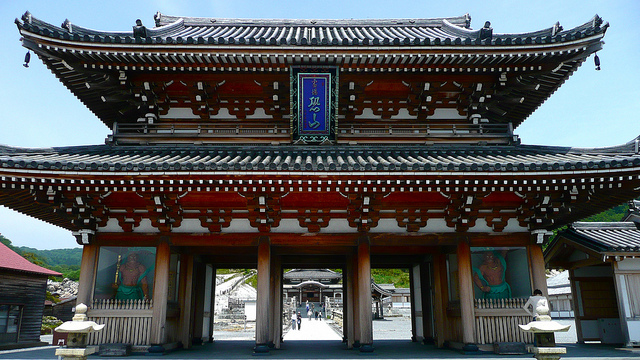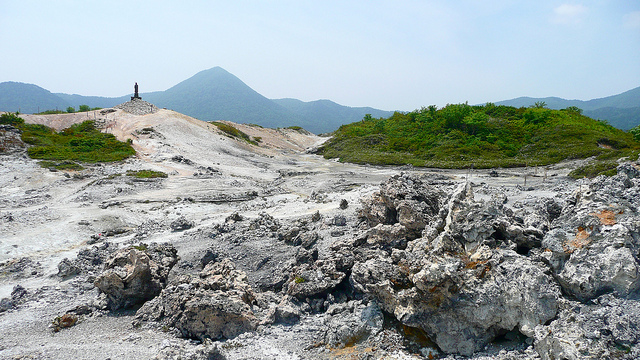
Osorezan, the sacred ground located in Shimokita Peninsula of Aomori prefecture. The locals believe all people’s souls are directed to this place after their death. The lifeless scenery with volcanic gases blow out here and there reminds visitors of nothing but the hell. Sounds a little freaky? Unexpectedly, this place is well known as the sacred ground of Buddhism with a long history and honorable origin, as well as a great tourist destination with beautiful sceneries.
About Osorezan

photo by Herry Lawford
Osorezan is a Buddhism sacred ground locating in Shimokita Peninsula, the north end of Honshu Island. It is often called the Three Sacred Ground of Japan along with Koyasan in Wakayama prefecture and Hieizan in Shiga prefecture. It has been recognized as the place for memorial services for the deceased by the locals since En-nin, the pupil of Saicho who is the father of Tendai-zen, founded the Bodai-ji temple here in 862. In geological viewpoint, Mount Osore is recognized as an active volcano even though no eruption has been recorded in the past 10000 years. Some parts of Osorezan Bodai-ji temple are filled with volcanic gas with sulfurous odor. Such areas of Osorezan are lifeless without live animals or plants and has been compared to hell. Acidic water caused by volcanic gas is unsuitable for life, therefore there is least impurities in the groundwater producing crystal-clear water quality of Lake Usori and Sanzu River. The contrast between the breathtaking sceneries and the unrealistic eerie atmosphere is attracting many tourists from overseas as well as Japanese visitors.
Highlights of tour in Osorezan: Paradise and hell
There are many spots to view in the temple ground which are called “hell”, as well as Sanzu River and Gokuraku-hama that are located outside of the temple. Learning backgrounds of each spots in prior to visit Osorezan helps you to understand the view of after death and morality based on Buddhism that the Japanese has had since ancient times.
Sanzu River (The Styx)
The Japanese often use the expression “crossing Sanzu River” to express someone’s death. In Buddhism, Sanzu River runs between the other world and this world separating the two worlds. The dead must cross this river to travel to the hell or heaven. The river running in front of the main gate of Osorezan has been named after Sanzu River and the bright red arched bridge over the river leads visitors to the Bodai-ji temple.
Datsue-Ba and Ken-e-Oh
Two statues standing nearby the Sanzu River. It is said that Datsue-Ba strips clothes off the dead and Ken-e-Oh hangs the clothes on the nearby tree branch to assess the gravity of the sins.
Muken-jigoku (The Avici Hell)
The lowest level of the hell in Buddhism. It is said that the dead who had repeatedly committed grave misdeeds such as butchery, theft and murder while they were living their lives are sent to this hell. This is the most painful hell of all where the dead must suffer from endless tortures of all kinds.
Sai-no-Kawara (The Children’s Limbo)
In Japan, dying earlier than parents has been recognized as the worst misdeed against parents committed by children. Sai-no-Kawara is the children’s limbo where the dead children are forced to pile pebbles to make a tower. They are allowed to get out of the limbo once they complete the tower. However, Oni (ogres) come and destroy the piled pebbles everytime they are about to finish the tower, and children end up endlessly continuing the work. This sounds extremely unfair, but it is said that their souls are eventually saved by Jizo-Bosatsu (Kshitigarbha in Sanscrit).
Pinwheels
At Osorean, you will see many pinwheels blowing in the wind here and there. These pinwheels have been placed to comfort the spirits of young children who died young.
Gokuraku-hama (Paradise shore)
After passing through the area called “the hell”, the peaceful landscape of Lake Usori spreads there with crystal-clear water and the long spread white shore. Contrasting the barren view of the hell, it looks as if in the paradise.
Experience Japanese Buddhism at Shukubo
If you are confident in Japanese language, the most recommended activity here can be staying overnight at “Shukubo”. Originally, Shukubo was an accommodation for Buddhist monks or pilgrims, but they accept general tourists as well. Kisshokaku, a shukubo at Osorezan, has modern looking as is a city hotel. But unlike an ordinary hotel, there are rules such as curfews and meal time (Guests are allowed to use light in the guest rooms any time). At meal time, all the guests gather in the dining hall to have vegetarian meal after listening to preaching by a Buddhist priest and saying “Gokan no ge”, the words to show appreciation for everyday meals. In the morning, guests attend the morning service then have vegetarian breakfast. There are a few hot-spring-bath houses in the temple ground that is free for visitors as well as the shared bath rooms for guests staying in Shukubo. The other privilege to stay at Shukubo is to enjoy the peaceful sceneries of Osorezan in early morning and late evening. Osorezan shows totally different face without daytime crowds in these time of a day.
Shukubo Kisshokaku
Inquiry: 0175-22-3825
Seances by Itako, Osorezan Taisai and Osorezan Akimatsuri
There are two important annual events held at Osorezan: Osorezan Taisai (Grand Festival) held 20-24 July and Osorezan Akimatsuri (Autumn Festival) held during long weekend in early October. Many viewers visit Osorezan during these periods every year to see Buddhist memorial service, prayers and procession. Among other things, “Kuchiyose” performed by Itako, spiritual mediums, attract the most attentions from tourists. Kuchiyose is séance to communicate with the dead via mouth of a medium. Many itakos living in surrounding areas gather in Osorezan during the festival periods. This year, Osorezan Taisai and Osorezan Akimatsuri will be held by following schedule.
Osorezan Taisai (Grand Festival): 20-24 July 2017
Osorezan Akimatsuri (Autumn Festival): 7-9 October 2017
Access & Admission
Name: Osorezan Kyaradasen Bodai-ji
Address: 3-2 Tanabu Usoriyama, Mutsu-shi, Aomori
Inquiry: 0175-22-3825
Open season: 1 May – Mid October 6:00~18:00/Mid – End of October 6:00~17:00
※No entry November – April
Admission fee: 500yen
※Same during Osorezan Taisai and Akimatsuri
Access: 35mnutes by bus from JR Shimokita Station of Ominato Line
Fear Mountain, where the dead souls rest in peace
Locating at the north end of Honshu Island, Osorezan is a place that express the other world in reality. Once you cross the arched bridge over Sanzu River, you will feel as if you have set your foot in the world after death. This is a well-known tourist destination of Mutsu city, though, many people visit here for the purpose of memorial services and pilgrimage as well. So, refrain from talking in laud voice to show your respect to the place when visiting here.
